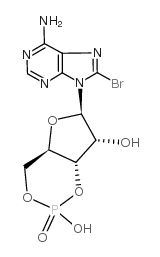8-bromo-Cyclic AMP

8-bromo-Cyclic AMP structure
|
Common Name | 8-bromo-Cyclic AMP | ||
|---|---|---|---|---|
| CAS Number | 23583-48-4 | Molecular Weight | 408.10200 | |
| Density | 2.8 g/cm3 | Boiling Point | 741.9ºC at 760 mmHg | |
| Molecular Formula | C10H11BrN5O6P | Melting Point | 254ºC (dec.)(lit.) | |
| MSDS | Chinese USA | Flash Point | 402.5ºC | |
|
Intramitochondrial adenylyl cyclase controls the turnover of nuclear-encoded subunits and activity of mammalian complex I of the respiratory chain.
Biochim. Biophys. Acta 1853(1) , 183-91, (2015) In mammalian cells the nuclear-encoded subunits of complex I are imported into mitochondria, where they are assembled with mt-DNA encoded subunits in the complex, or exchanged with pre-existing copies in the complex. The present work shows that in fibroblast ... |
|
|
Antipruritic mechanisms of topical E6005, a phosphodiesterase 4 inhibitor: inhibition of responses to proteinase-activated receptor 2 stimulation mediated by increase in intracellular cyclic AMP.
J. Dermatol. Sci. 76(3) , 206-13, (2014) Phosphodiesterase 4 (PDE4), which catalyses the conversion of cyclic adenosine 3',5'-monophosphate (cAMP) to 5'-AMP, plays a critical role in the pathogenesis of inflammatory disorders. Pruritus is the main symptom of dermatitides, such as atopic dermatitis, ... |
|
|
T-2 toxin regulates steroid hormone secretion of rat ovarian granulosa cells through cAMP-PKA pathway.
Toxicol. Lett. 232(3) , 573-9, (2015) T-2 toxin is a secondary metabolite produced by Fusarium genus and is a common contaminant in food and feedstuffs of cereal origin. In porcine granulosa cells(GC), T-2 toxin has been shown to inhibit the steroidogenesis; however, the mechanism has not been we... |
|
|
Ca2+ and cAMP signaling pathways interact to increase the diuretic effect of serotonin in Malpighian tubules of the kissing bug. Focus on "Serotonin triggers cAMP- and PKA-1-mediated intracellular calcium waves in Malpighian tubules of Rhodnius prolixus".
Am. J. Physiol. Regul. Integr. Comp. Physiol. 307(7) , R819-21, (2014)
|
|
|
Regulation of ecto-apyrase CD39 (ENTPD1) expression by phosphodiesterase III (PDE3).
FASEB J. 27(11) , 4419-28, (2013) The ectoenzyme CD39 suppresses thrombosis and inflammation by suppressing ATP and ADP to AMP. However, mechanisms of CD39 transcriptional and post-translational regulation are not well known. Here we show that CD39 levels are modulated by inhibition of phosph... |
|
|
Presynaptic kainate receptor-mediated facilitation of glutamate release involves Ca2+-calmodulin and PKA in cerebrocortical synaptosomes.
FEBS Lett. 587(6) , 788-92, (2013) We have explored the mechanisms involved in the facilitation of glutamate release mediated by the activation of kainate receptors (KARs) in the cortex using isolated nerve terminals (synaptosomes). Kainate (KA) produced an increase on glutamate release at 100... |
|
|
A striatal-enriched intronic GPCR modulates huntingtin levels and toxicity.
Elife 4 , (2015) Huntington's disease (HD) represents an important model for neurodegenerative disorders and proteinopathies. It is mainly caused by cytotoxicity of the mutant huntingtin protein (Htt) with an expanded polyQ stretch. While Htt is ubiquitously expressed, HD is ... |
|
|
Roles of calcium/calmodulin-dependent kinase II in long-term memory formation in crickets.
PLoS ONE 9(9) , e107442, (2014) Ca(2+)/calmodulin (CaM)-dependent protein kinase II (CaMKII) is a key molecule in many systems of learning and memory in vertebrates, but roles of CaMKII in invertebrates have not been characterized in detail. We have suggested that serial activation of NO/cG... |
|
|
Differential expression and regulation of Tdo2 during mouse decidualization.
J. Endocrinol. 220(1) , 73-83, (2014) Tryptophan 2,3-dioxygenase (Tdo2) is a rate-limiting enzyme which directs the conversion of tryptophan to kynurenine. The aim of this study was to examine the expression and regulation of Tdo2 in mouse uterus during decidualization. Tdo2 mRNA was mainly expre... |
|
|
Calcium ameliorates renal cyst growth in metanephric organ culture: a morphological study.
J. Environ. Pathol. Toxicol. Oncol. 31(3) , 285-93, (2012) Polycystic kidney disease (PKD) is associated with alterations in developmental processes that severely affect kidney integrity, often leading to fatal consequences. It has been suggested that dysfunctional calcium (Ca2+) regulation associated with the PKD ph... |